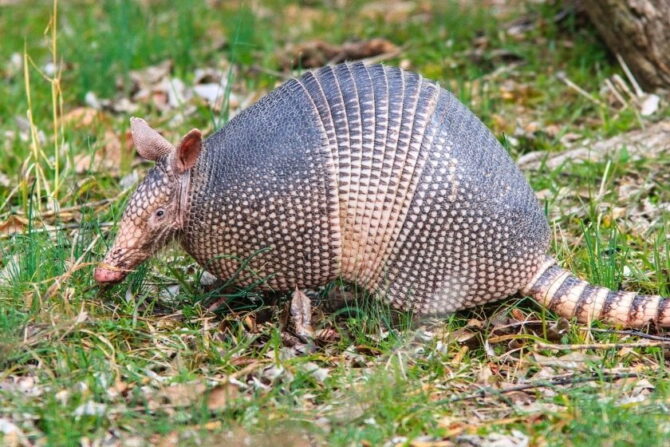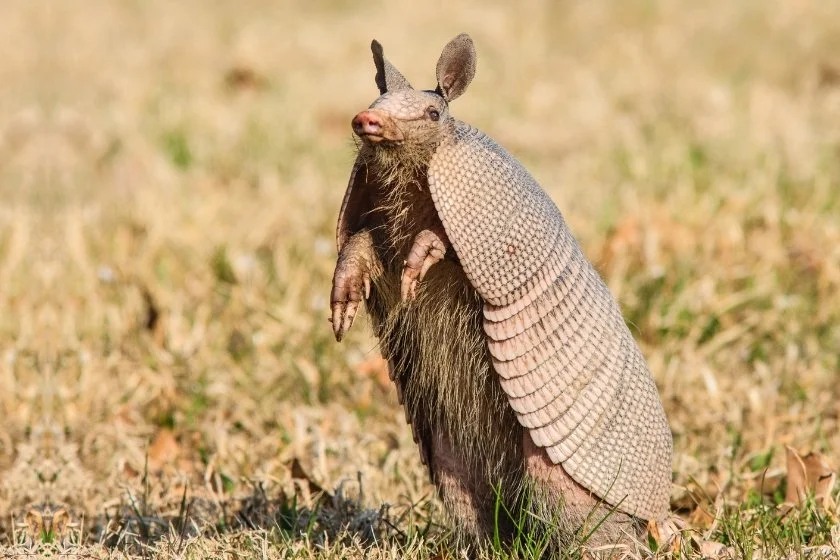The armadillo has thick skin, and it is often rumored that they can take bullets and walk off unharmed.
The skin also seems to have inspired a lot of bulletproof vests as they were developed by scientists using the same technology found in the resistant shells of the armadillos.
This begs thought-provoking questions related to their skin—are armadillos bulletproof? Are they born with armor?
The answer is no. Armadillos are not entirely bulletproof, though their bodies are resistant to bullets and can protect them from gunshots.
These animals come with a rigid, rough shell that isn’t present at birth, which develops as they grow.
Read on to find out more interesting facts.
Do Armadillos Have Armor?
Armadillo is a barrel-shaped Dasypodidae family animal that resembles a pig and a medieval knight with a tough and rough outer interlocking shell that serves as its natural body armor.
This outer shell is formed by loosely attached bony plates called osteoderm, which grows naturally on the skin and forms flexibility.1
Another protective layer is keratin, the same protein that gives horns and nails their shape. This layer enables them to easily evade predators by charging deep into thorny plants and shrubs where no one can reach them.2
The reason armadillos have this covering is solely for protection against predators. When threatened or cornered, they instinctively roll themselves into a ball-like shape in a defensive position.
When they do this, the scally bones on their body overlap to add fortification to the vulnerable parts such as the head, tail, and legs.
For example, there was an incident of a Texas man who landed in a hospital after he tried shooting a curled-up armadillo, and the bullet ricocheted back and hit him.3
Perhaps this could be one reason the name armadillo in Spanish means “little armored one.”
Are Armadillos Born With Armor?

Young armadillos—called puppies—do not come with hard shells. Rather, they are born with very soft shells that feel more like leather to the touch.
Like many other mammal babies, they are usually vulnerable. They depend on the protection of their mothers to survive. The latter dig burrows in safe locations to protect the pups.
Some other reproductive facts include the gestation period and weaning. The gestation period of the female Armadillo is between 2 and 5 months.
After that, she gives birth to 1 to 12 young armadillos. It is very common for these mammals to give birth to twins, quadruplets, or more identical offspring.
These pups grow and mature quickly and are weaned between two to four months. Between the ages of 9 to 12 months, they can start their own family and have offspring.
Armadillos have a relatively long lifespan and can live up to 30 years depending on health and other factors, but most armadillos are between 12 to 16 years old.
Are Armadillos Bulletproof?

For starters, note that the term “bulletproof” is a loose word often used by sales companies to exaggerate and promote various body armor or glass armor.
No material on earth is really “bulletproof”. Materials can only be said to be resistant to bullets or penetration, which varies as some materials have greater resistance than others.
Going by this, one can’t say any animal is completely bulletproof, including the armadillo.
The resistance of any fabricated bulletproof will weaken if continually shot. Similarly, this mammal can still be killed if shot repeatedly or if the impact is strong.
This doesn’t make the armor useless, though. Just as we’ve seen, the shell can resist bullet and protects it from predators.
How Strong is Armadillo Shell?

Armadillos are the only creatures in the world known to have the strongest armor or shells. Not only are their shells strong, but they are also flexible, enabling them to walk fast on land without impediments, burrow, and even swim.
However, predators know how to get their way around the shell by striking at the Armadillo’s unprotected underbelly.
Since not all armadillos can curl themself into a ball-like defensive position, they use other methods to protect themselves when a predator tries to outmaneuver them.
They could stand motionless to trick the animal and patiently wait for it to leave. If it does not work, the Armadillo will do what most folks would do when they see a predator— scamper for safety and hide!
Even though armadillos have been said to have poor vision, they are quite the expert at finding quick hiding burrows in the heat of an attack.
Armadillos have also been known to jump at attackers when threatened, which will startle the predator and gives the Armadillo a little time to make haste for the quickest and nearest burrow or safe spot to hide.
A winning move of theirs is the rolling ball move. This is often done by the three-banded armadillo species, and only they can carry out this stunt.
They roll into a ball-like shape with the head and legs tucked into its shell. Everywhere becomes a fortress and virtually leaves no vulnerable flesh for the predator to hurt.
Additional Armadillo Facts
Size and description
There are several species of armadillos, up to 20 of them, but only one specie lives in Latin America, and they are the only mammals in the world endowed with such body armor.
Many have likened armadillos to turtles, maybe because of their bony exteriors, but in reality, armadillos have no relation to turtles. Rather, their only known closest relatives are sloths and anteaters.
These little medieval knights also come in different sizes, shapes, and colors: In size, big adult armadillos can grow up to five feet or more and weigh up to 120 pounds which is the equivalent size of a man.
In color, they can come in red, pink, dark brown, gray, yellow, and even black.
Location
You can only find armadillos in warm habitats with temperate grasslands, rainforests, and deserts. This is because armadillos naturally hate cold regions due to their low metabolic rates.
Cold regions threaten them and may wipe out their entire population. Based on available data from the University of Michigan, countries such as Argentina and United States are some of the few countries in the world where you can find armadillos for now.
Another reason why armadillos are extremely picky in their choice of habitat is the soil type.
They prefer loose or porous soils such as sandy and loamy to make digging and foraging for food easier and create burrows.
Behavior
Naturally, armadillos do not belong to the class of social animals. They sleep almost all day, about 16 hours per day, according to National Geographic, and they only come out in the mornings and evenings to forage for food.
The only time you can see a group of armadillos together is during cold periods when they either want to mate or share body heat to keep themselves warm.
Armadillos take heat very seriously; as a result, during cold, you may find a group of armadillos hunkering down in one burrow together to share body heat.
There have been cases when one Armadillo will also invite a group of armadillos into its burrow to share body heat.
Wrap Up
Armadillos should be given medals for their exceedingly strong shells. Though they aren’t the only animals with this ability, they have quickly gotten known for it.
However, these animals aren’t completely bulletproof. No material can be considered 100% resistant to a bullet, including the shells of an animal. That said, it is bullet-resistant and inspiration for bulletproof vests.
References & Notes
- Langley L. (2019). These animals inspire better body armor for humans. National Geographic.
- Bragulla H. H., Homberger G. D., Structure and functions of keratin proteins in simple, stratified, keratinized and cornified epithelia. J Anat. 2009 Apr; 214(4): 516–559.
- Texas man injured as bullet ricochets off armadillo. (2015). BBC News.
